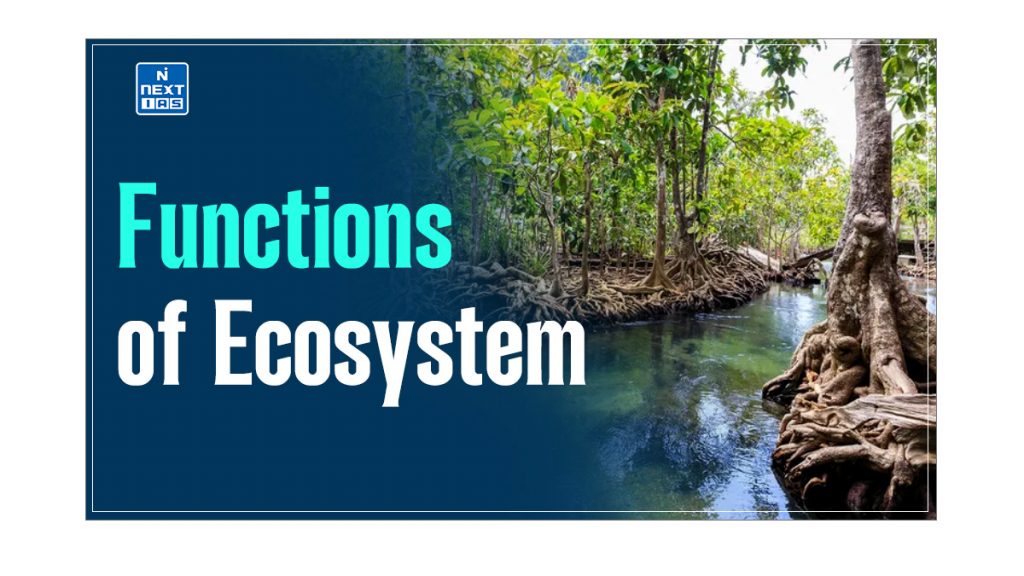
Functions of Ecosystem are important for maintaining ecological balance and supporting life on Earth. Understanding these functions is fundamental for addressing environmental issues and managing natural resources effectively. This article aims to study in detail various functions of ecosystem, including Energy Flow and Nutrient Cycling among other and their significances.
What is Ecosystem?
- An ecosystem is a functional unit of nature where a community of living organisms interact among themselves and with the surrounding physical environment.
- An Ecosystem varies greatly in size and may be as large as a forest or sea or as small as a small fishpond, which provides a home for plants and other small animals.
Read our detailed article on the Basic Concepts of Ecosystem.
Major Functions of Ecosystems
- The ecosystem has some functional properties that keep all the components interlinked and running together.
- Various components of the ecosystem are seen to function as a unit when the below-mentioned aspects are considered:
- Productivity
- Decomposition
- Energy Flow
- Nutrient Cycling
Each of these functions of ecosystem is discussed in detail in the sections that follow.
Productivity
- Productivity in an ecosystem refers to the rate at which biomass is produced.
- It’s essentially the energy accumulated by plants through photosynthesis and subsequently transferred through the food chain.
- There are two main types of productivity – Primary Productivity and Secondary Productivity.
Primary Productivity
- Primary production refers to the quantity of biomass or organic material generated by plants per unit area within a specific time frame through the process of photosynthesis.
- Thus, it is one of the most important functions of ecosystem, forming the basis of sustenance of life.
- The rate of biomass production is called ‘primary productivity’ or simply ‘productivity’.
- Primary productivity varies in different types of ecosystems and depends on the inhabiting plant species as well as a variety of environmental factors, including photosynthetic capacity of plants and availability of nutrients.
Gross Primary Productivity (GPP)
The Gross Primary Productivity (GPP) of an ecosystem refers to the rate of production of organic matter during the process of photosynthesis.
Net Primary Productivity (NPP)
- Net Primary Productivity (NPP) is the biomass that is available for the consumption of heterotrophs (herbivores and decomposers).
Net Primary Productivity (NPP) = Gross Primary Productivity (GPP) – Respiration
- Thus, it is, basically, the amount of energy stored in plant tissues after respiration, and which is available to the next trophic level.
- The annual Net Primary Productivity (NPP) of the whole biosphere is approximately 170 billion tons (dry weight) of organic matter.
- Of this, the productivity of the oceans are only 55 billion tons, despite occupying about 70 per cent of the surface. Rest of course, is on land.
Secondary Productivity
- This is the rate at which consumers convert the energy they acquire from food into new biomass.
- Consumers define secondary productivity as the rate of formation of new organic matter.
- It is also one of the most important functions of ecosystem, forming the basis of the flow of energy.
Decomposition
- Decomposition refers to the process wherein decomposers break down complex organic matters into simpler inorganic substances like carbon dioxide, water and nutrients.
- Dead organisms are the raw material for decomposition.
- Decomposition is largely an oxygen-requiring process.
Humification
- It occurs during decomposition in the soil.
- It leads to the accumulation of a dark-coloured amorphous substance, called Humus.
- Humus is highly resistant to microbial action and decomposes at an extremely slow rate.
- Also, being colloidal in nature, it serves as a reservoir of nutrients.
Mineralisation
Some microbes further degrade the humus, and the release of inorganic nutrients occurs by the process known as mineralisation.
Energy Flow
- Energy flow in ecosystems refers to the movement of energy through a series of organisms, starting from primary producers to various levels of consumers.
- All the components of an ecosystem constantly interact with each other, which leads to the growth and regeneration of its plants and animal species.
- For this interaction to operate and continue, energy is required.
- The Sun is the ultimate source of energy for all the ecosystems in the world, except for the deep sea hydrothermal ecosystems.
- Energy from the sunlight is captured by primary producers and converted into chemical energy.
- This energy then moves from one organism to another as they consume one another.
- Thus, this is one of the most important functions of ecosystem, allowing organisms to survive and thrive.
Read our detailed article on Energy Flow in Ecosystem.
Nutrient Cycling
- Nutrient Cycle, also known as Biogeochemical Cycle, is the process by which essential elements and compounds move through the Earth’s ecosystems, connecting the biotic (living) and abiotic (non-living) components.
- These cycles, as one of the most important functions of ecosystem, ensure the continuous availability of nutrients required for the growth, survival, and reproduction of organisms.
- Some of the important nutrient cycles in an ecosystem include:
- Carbon Cycle
- Nitrogen Cycle
- Water Cycle or Hydrological Cycle
- Phosphorous Cycle, and
- Sulphur Cycle
Read our detailed article on the Nutrient Cycle.
Conclusion
Various functions of ecosystem are integral to the health and sustainability of our planet. By understanding these functions, we can better manage and protect our natural resources. Effective conservation and sustainable management practices are necessary for ensuring that the invaluable functions of ecosystem continue for present and future generations.
GS - 3





